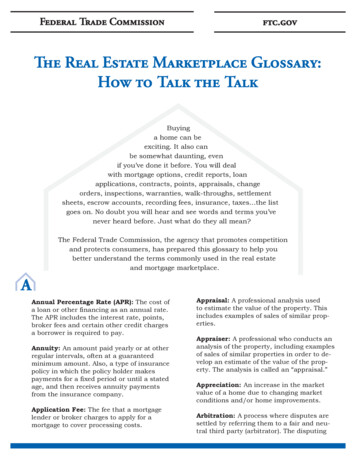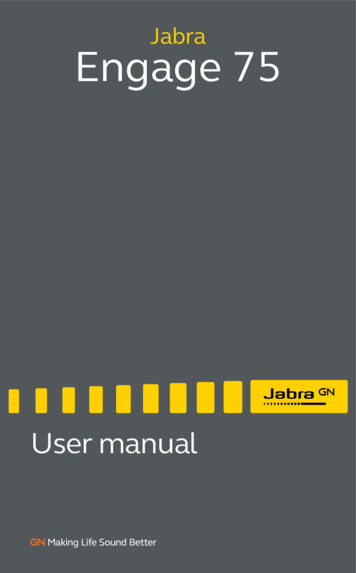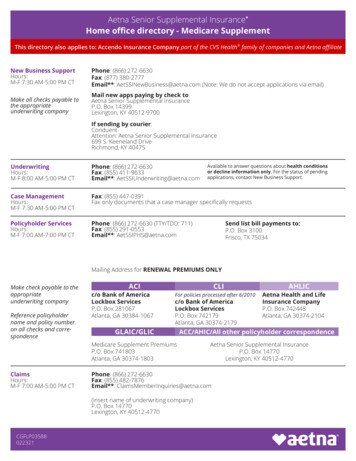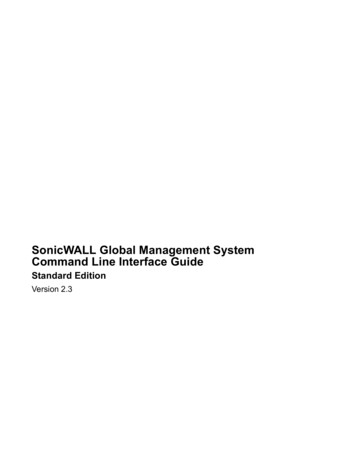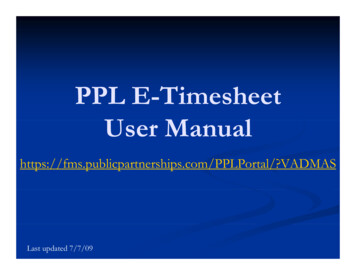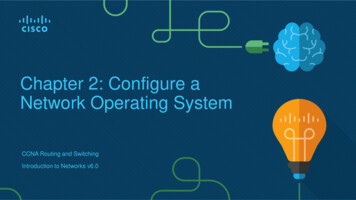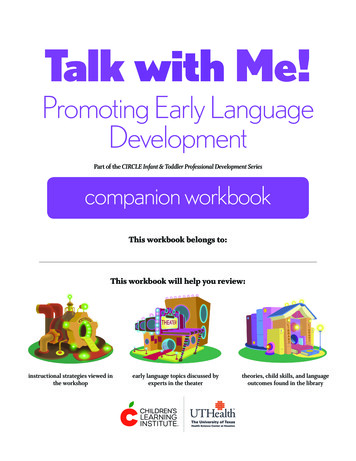
Transcription
Talk with Me!Promoting Early LanguageDevelopmentPart of the CIRCLE Infant & Toddler Professional Development Seriescompanion workbookThis workbook belongs to:This workbook will help you review:instructional strategies viewed inthe workshopearly language topics discussed byexperts in the theatertheories, child skills, and languageoutcomes found in the library
2017 The University of Texas Health Science Center at Houston. All rights reserved.CHILDREN’S LEARNING INSTITUTEUniversity of Texas Health Science Center at Houston7000 Fannin, Suite 2300Houston, TX 77030E: ms.cli@uth.tmc.eduW: childrenslearninginstitute.org
ContentsNavigating this Workbook4Part 1Part 3WORKSHOP: INSTRUCTIONALSTRATEGIESWORKSHOP: INSTRUCTIONALSTRATEGIESLabel6Ask Questions35Describe7Pace37Compare8Encourage Conversation38Explain9Invite Participation39Scaffold41THEATER: HEAR THE EXPERTSWhat Language Does for Us11THEATER: HEAR THE EXPERTSTypes of Language11Learning Multiple Languages42Language & Early Brain Development12Supporting Dual Language Learners43Effects of Poverty43Academic & Social Outcomes44Part 2LIBRARY: ACADEMIC & SOCIALOUTCOMES45WORKSHOP: INSTRUCTIONALSTRATEGIESREFERENCES47LIBRARY: CHILD SKILLDEVELOPMENT14Link17Narrate18Think Aloud19Rephrase20Extend21THEATER: HEAR THE EXPERTSThemes from Theories23What Works & What Doesn’t23Types & Causes of DevelopmentalDelays26LIBRARY: CONNECTIONS TOTHEORY27
Navigating this WorkbookThis companion workbook covers all three parts (i.e., course modules) of the Talk with Me series. Each part is organized bythe three categories below:THE WORKSHOP:The workshop in the Talk with Me course seriescontains videos filmed with real caregivers thatdemonstrate the key instructional strategies forsupporting infant and toddler language development.There are a total of 14 strategies, spread acrossthe three parts of the series. These strategies aresummarized in this workbook. You may find it helpfulto review them as you practice implementing strategiesin your classroom.THE THEATER:The theater in the course contains interviews withexperts on a wide variety of topics related to infant andtoddler language development. Each part in the courseseries contains new expert videos. The key conceptspresented in these videos are summarized in thisworkbook.THE LIBRARYThe library provides resources for you to dive deeperin your learning about early childhood developmentconcepts. We’ve summarized the three sections in thelibrary in this guide:InstructionalStrategiesHear fromthe ExpertsDive Deeper Child Skill Development (Part 1) Connections to Theory (Part 2) Academic and Social Outcomes (Part 3) 2017 The University of Texas Health Science Center at Houston. All rights reserved.Page 4
Part 1 2017 The University of Texas Health Science Center at Houston. All rights reserved.Page 5
PART 1THE WORKSHOP:InstructionalStrategies1 LabelLabels are names for objects, concepts, and actions. It’s best to provide labels for objects when children areactively engaged with that object or in that action. Since they are already paying attention, children easilyconnect what you are saying to the appropriate object or action.To help build children’s vocabulary, caregivers can label objects, concepts, and actions throughout the day,including during playtime, book reading, and everyday activities like meal time, diaper changing, or potty time.Tips Labeling objects and actions can be as simple as telling a baby what she is holding, or labeling heractions as she plays with a toy. Looking at books together is a great opportunity for labeling. Babies learn to love books when they areintroduced in flexible and fun ways. Label items in the pictures, and let them touch and turn the pagesof the book. Encourage them to point to different things on the page, label what they point to, andshow excitement when they seem to understand your words. Learning vocabulary is easier in the context of play, and acting out new words helps childrenunderstand their meaning. When engaging in activities that have a lot of physical movement,demonstrate and label each action and encourage children to do it too!Rate Yourself!How comfortable do you feel with using the labeling strategy in your classroom?Not at all comfortable Somewhat comfortable 1 2 3 4Very comfortable 5 6 2017 The University of Texas Health Science Center at Houston. All rights reserved.Page 6
PART 1Stop and Reflect: LabelingWhat classroom activities do you have planned for this week? Can you think of some labels that youcould use during these activities to enrich the language experience for the children?2 DescribeDescribing is telling how something looks, tastes, sounds, feels, moves, or smells. Examples of these kinds ofdescribing words include: sweet, cold, soft, fast, slow, rough, wet, dry, sticky, fast, slow, blue, small, wiggly,dark, heavy, empty, tall, short, orange, round, delicious, and bumpy. Describing words can also be used totalk about feelings and internal states, such as: happy, sad, tired, hungry, mad, frustrated, sick, shy, or proud.Describing words are part of building a rich vocabulary that children can use to communicate more fully abouttheir experiences and observations.Tips Spending time outdoors is a great opportunity to let babies to explore with all of their senses whileoffering rich language descriptions. Describing includes talking about feelings, like happy, sad, and mad. It’s normal for babies to fuss,especially when they are hungry, tired, or frustrated. When you respond to them with a comforting voice,describe their feelings, provide gentle cuddling, and solve the problem as soon as you can, babies feel moresecure and settle down faster. Another way to use describing words is to talk about locations, such as in the box, out of the car, or on theblanket. These are words that often come up when playing with toys. Art activities are a great time to use describing words because they often involve new sensory experiences.You can talk about how things feel, smell, and look and use words like cold, smooth, and squishy.Rate Yourself!How comfortable do you feel with using the describing strategy in your classroom?Not at all comfortable Somewhat comfortable 1 2 3 4Very comfortable 5 6 2017 The University of Texas Health Science Center at Houston. All rights reserved.Page 7
PART 1Stop and Reflect: DescribingArt is one type of activity that really lends itself to the describing strategy. What other kinds of activitieswould spur conversations about how things look, taste, sound, feel, move, or smell?3 CompareComparing is telling how items are the same (or not the same). Comparisons may start with “They areboth ”, for example “Your shirt is the same color as this crayon! They are both red.” “See the daisy andthe rose? They are both flowers.” Comparisons may also include talking about opposites such as big/small,hot/cold, and wet/dry. Making comparisons between objects that children can see, hear, or touch helpschildren understand these concepts.Examples of comparing: “These noodles are different lengths. Which one is the longest?” “The daddy elephant is big, and the baby elephant is small.” “This shape is a triangle. It has three sides. A rectangle has four sides like this block.”Tips Comparing often includes talking about opposites like in and out or up and down. When caregivers pairsimple comparison words with corresponding actions, like throwing a ball up and down, even babiescan begin to recognize comparisons between two objects or ideas. Children need hands-on experiences to understand some concepts and comparisons. Words like warmand cool are meaningful when they are paired with real life sensations. Of course we need to keepchildren safe from touching dangerous things, so caregivers need to look for safe opportunities to teachthese concepts.Rate Yourself!How comfortable do you feel with using the comparing strategy in your classroom?Not at all comfortable Somewhat comfortable 1 2 3 4Very comfortable 5 6 2017 The University of Texas Health Science Center at Houston. All rights reserved.Page 8
PART 1Stop and Reflect: ComparingWhat is a common activity for your classroom? What items, qualities, or actions in the activity can youcompare for children?4 ExplainExplaining tells how things work or why we do things. Young children do not always have the experienceto know the reasons behind our actions or rules, and the things that happen around them. Givingexplanations helps children begin to understand the world and can also increase their cooperation withrules.Examples of explaining: “We are going to walk quietly past Ms. Patty’s room because the babies are sleeping.” “We use sponges to clean our dirty spoons, plates, and cups after we eat.” “If we run in the house, we might fall and get hurt.”Tips Babies are often carried around without understanding where they are going or why. This may makethem feel helpless and confused. Remembering to explain things to young children takes practice, butit is an important way to show sensitivity and care. Explanations also help babies learn to understandnew words like waiting, going, and moving when they hear them many times. Remember that babies’ brains are starting to process language many months before they begin to talk.By starting to give babies explanations for what is happening, you are helping them learn about thesounds of their language as they transition from one activity to another. When children can hear an explanation and see the related actions, it helps them understandconnections between cause and effect. Consider a scenario in which a book gets torn up; the teacher’sexplanation can help her toddlers understand the connection between how the book got broken andhow they can fix it. Children understand explanations better when they can see and try things for themselves. Thinkabout an activity in which you’re looking for something with a magnifying glass. If a teacher explainswhat she’s doing, shows the child how to do it, and lets the child try for herself, this combination oflanguage, demonstration, and practice provides a rich learning experience for the child. 2017 The University of Texas Health Science Center at Houston. All rights reserved.Page 9
PART 1Rate Yourself!How comfortable do you feel with using the explaining strategy in your classroom?Not at all comfortable Somewhat comfortable 1 2 3 4Very comfortable 5 6Stop and Reflect: ExplainingCan you think of something that has a confused a child in your classroom recently? How could youhave better explained what happened? 2017 The University of Texas Health Science Center at Houston. All rights reserved.Page 10
PART 1THE THEATER:Hear fromthe ExpertsWHAT LANGUAGE DOES FOR USPragmatic Language SkillsPragmatic skills are the social aspects of communication, and include receptive and expressive skills.For example, when infants learn how to take turns and coo and babble back and forth, they are learningimportant conversation skills—taking turns talking and listening, paying attention to facial expressions andtone of voice, and making eye contact.Pragmatic skills also include adjusting how we talk based on who we’re talking to—for example, thedifference between talking to a younger child or talking to your parents.Pragmatic language is learning to communicate in culturally appropriate, sensitive ways.Receptive LanguageReceptive language is what children understand about what they hear. We can look at how much theyunderstand by how they respond nonverbally—for example, do they point to an object when you say thename of the object, and do they follow simple instructions like, “let’s find your shoes!”Receptive language also includes the ability to understand grammar and sentence structure: For example,do they understand the difference between “The dog chased the cat” and the “The cat chased thedog.”Receptive language starts developing very early in the first year of life, when they are not yet able totalk back to caregivers.TYPES OF LANGUAGELanguage Relation to Other Areas of LearningReading: Children who have strong oral language skill and better vocabulary are likely to go on to becomebetter readers because they already know a lot about words and grammar. Children move from just readingwords on a page to really understanding and thinking about what they are reading.Math: Teaching word concepts such as more / less than, same / different, one / none, first / last areimportant math vocabulary. The more concept vocabulary children learn, the more prepared they will be tounderstand more math activities.Social Emotional Development: When children can use words to express how they are feeling, instead ofcrying or pushing, then the words they use are supporting behavioral self-control, an important part ofsocial and emotional development. 2017 The University of Texas Health Science Center at Houston. All rights reserved.Page 11
PART 1Components of LanguageFour components:1.Sound (phonetics) – sounds that we make, and combining sounds into syllables2. Semantics – meaning behind vocabulary words- verbs, concepts words (up, down), descriptive words(fuzzy, warm, round, red) and how words relate to each other (e.g. synonyms)3.Morphology and syntax – morphology is the smallest unit of meaning that you can add to a word tochange its meaning. For example, adding an “s” to make something plural, or adding an “ed” to make averb past tense. Syntax is how you put words together (grammatical rules). These are different acrosslanguages, which sometimes makes it difficult to learn a new language.4. Pragmatic language – the function of language and the cultural expectations for the ways wecommunicate.LANGUAGE AND EARLY BRAIN DEVELOPMENTTalking to Babies Helps Brain DevelopmentTalking to babies when they do not have language yet is important for their brain development. The brainis naturally attuned to hear language and to want to pay attention to language. Babies begin to developlanguage by hearing it consistently over time. One-on-one communication also helps build trustingrelationships, even when the baby cannot understand the words spoken.Importance of LanguageLanguage is a fundamental part of children’s development. It is the way we communicate, express feelingsand ideas, share and request information, etc. Language also connects to so many areas of development,that if a child does not have functional language skills, the child feels frustrated and socially isolated.Language and Math and ScienceIf infant and toddlers receive rich language support and build meaning of their world, understandingwhat things are called and how they function, then they understand concepts like more and less, biggeror smaller, higher or lower. These early concepts prepare children from more complex science and mathactivities in preschool and kindergarten.The Environment and Brain DevelopmentThe brain in infancy has as a complex web of connections, called synapses. Some synapses should bestrengthened and some should be “pruned,” or lost, because they make the brain less efficient. Richlanguage input during the first three years of life helps the brain determine which connections to saveand which to prune. Without language, this pruning process can result in a brain architecture that isn’t asefficient at taking in input and making meaning of it. Research has shown that children who grow up inenvironments with little language and a lot of stress process words significantly slower than their peers.This effect on the brain can be seen at 18 months and continues to affect children as they age. 2017 The University of Texas Health Science Center at Houston. All rights reserved.Page 12
PART 1How Babies Learn to TalkBabies generally take the whole first year of life to: Listen to language around them and try to make sense of it Practice language through cooing, babbling, and approximating words Understanding that they can communicate with other people, first through gestures or actionAround age one, they put all of these skills together to form their first words.General strategies to help babies learn to talk include: Exposing children to lots of clear talk Using lots of different words and repeating them often Gesturing to provide an added layer of meaning to words Talking about and labeling things they are interested in Teaching them the back and forth motion of conversation 2017 The University of Texas Health Science Center at Houston. All rights reserved.Page 13
PART 1THE LIBRARYChild Skill Development:LanguageRECEPTIVE0-3 MONTHS Startles at loud sounds Quiets or smiles when spoken to Starts to turns eyes or head towardsoundsEXPRESSIVE Cries; by 3 months will start to make different cries fordifferent needs (hungry, tired) Makes pleasure sounds (coos and goos)3-6 MONTHS Responds to changes in tone of voice Laughs aloud Begins to turn in response to name Starts to babble with sounds like p, b, m Responds to music and singing Vocalizes to get attention, express displeasure, showeagerness Produces raspberries, squeals, trills May start to imitate sounds s/he hears Takes turns making sounds with others6-9 MONTHS Watches your face when you talk Does reduplicative babbling (e.g., “bababa”, “gagaga” Understands 3-50 words Babbles with inflection and rhythmic patterns Recognizes the sight of spoon, bottle May start to clap hands and bang purposefully to makenoise Starts to recognize names of familymembers Understands “hi” and “bye” Starts to understand “no” Recognizes name9-12 MONTHS Participates in language games such aspeek-a-boo and patty cake By 12 months, has 1-2 words including sounds withmeaning such as “Mama”, “Dada”, “Uh-oh” Imitates familiar sounds Understands name of 1 body part Produces true words during sound play recognizes words as symbols for objects Uses several gestures like showing, giving, waving, andpointing Babbles with imitation of real speech and withexpression12-18 MONTHS Understands names of many objects shows early pretend play (e.g., uses spoon as telephone) points to several body parts Uses 5-50 words, including names Follows simple commands with gestures Points to show something s/he wants Shakes head and says “no” May start to combine words (e.g., “more cookie”, “car go”) 2017 The University of Texas Health Science Center at Houston. All rights reserved.Page 14
PART 1RECEPTIVE18-24 MONTHS Begins to understand simpleprepositions (e.g., “in” vs. “out”, “up” vs.“down”) Points to things or pictures when theyare namedEXPRESSIVE By 24 months should be regularly combining words. Uses words like “more” to make wants known Makes sounds of familiar animals Repeats words overheard Follows simple instructions withoutgestures Produces 25-200 words Points to objects in a book Can name objects common to surroundings Uses 1 pronoun (e.g., “me”, “mine”) Uses at least 2 prepositions (e.g., “up”, “in”)2-3 YEARS Matches 3-4 colors Names body parts Understands “big” and “little” Can say 200-900 words Likes to hear same story repeated Uses short sentences Follows instructions with 2 steps Asks questions like “What’s that?” or “Where’s my ?” Understands words like “in,” “on,” and“under” Uses quantitative words (e.g., “some”, “one”, “more”) Begins to understand “what” and“where” questions Understands simple questions dealingwith his/her environment and activities Identifies objects by function (e.g.,“Show me what we eat with”) Says first name, age, and sex Says words like “I,” “me,” “we,” and “you” and someplurals (cars, dogs, cats)2,3,4 Carries on a conversation using 2 to 3 sentences May carry on pretend conversation between self anddolls/stuffed animals Uses 2 word negative phrases such as “no want” Talks to other children as well as adults Speech is understood by most listeners most of the time Understands up to 1500 words by age 4 Can tell a story and relate events and experiences. Can group objects according to category Uses sentences of 4-5 words. Can follow commands with modifiers(e.g., Says 1000 words “Walk slowly to the car”) Understands names of different kinds ofanimals3-4 YEARS Understands 4 different prepositions. Understands one or more colors Understands concepts such as “longer”(vs. “shorter”) and “larger”(vs. “smaller”)when the contrast is presented Follows simple instructions even whenstimulus objects are not present (e.g.,“Go to the kitchen and get your shoes”) Beginning to understand time concepts(last night, tomorrow, yesterday,summer) Answers simple who, what, where, why questions Sings a song or says a poem from memory such as the“Itsy Bitsy Spider” or the “Wheels on the Bus” 3 Can say first and last name when asked. Speech is 90% intelligible with context Uses language for imaginative play Asks questions, makes requests, Can repeat words with 4 syllables Has most vowels and diphthongs and consonants p, b, m,w, n well established Names at least 1 or more colors correctly. 2017 The University of Texas Health Science Center at Houston. All rights reserved.Page 15
Part 2 2017 The University of Texas Health Science Center at Houston. All rights reserved.Page 16
PART 2THE WORKSHOP:InstructionalStrategies5 LinkLinking is making a connection between new objects, ideas, or concepts and something the child alreadyknows or has experienced. When we make these connections, children build understanding and are able toaccess the knowledge they are gaining.Examples of linking: “The apron your mom is wearing looks like the smock you wear when you paint in the Art center.” “You are pointing to a giraffe in your book. Do you remember we saw a giraffe at the zoo last week? Hewas eating leaves from the tall tree.” “That cat is black just like the one we saw when we were playing on the playground near grandma’shouse.”Tips Linking classroom activities with children’s personal experiences outside of school is a great way tostimulate children’s memory as well as encouraging conversational skills. If you don’t know much about a child’s home life or family, ask parents or guardians so you will haveinformation! The more you know about their lives outside of the classroom, the more information youhave to make links between classroom activities and babies’ personal experiences. For example, youcould ask: the names of brothers, sisters, and grandparents the kind of transportation the family uses if the family has pets at home what the baby’s favorite activities and toys are what the family did last weekend Links don’t always have to be about home and family. You can make links between activities and whatthe child did yesterday, or earlier that day on the playground. You can also talk about what mighthappen later that day, or during an upcoming vacation. What’s important is making a connectionbetween what is happening now and other experiences the child can remember or anticipate. Looking at pictures and books can remind teachers and children of past experiences to talk about.Making links to children’s personal experiences helps words and ideas feel more meaningful. It alsomay call up other memories that children want to talk about, which encourages rich conversation. 2017 The University of Texas Health Science Center at Houston. All rights reserved.Page 17
PART 2Rate Yourself!How comfortable do you feel with using the linking strategy in your classroom?Not at all comfortable Somewhat comfortable 1 2 3 4Very comfortable 5 6Stop and Reflect: LinkingThink about one child in your classroom. Try to remember the last time the child was very excited.What was he or she excited about? How might future activities be related to that child’s experience,and how can you link the two?6 NarrateNarrating is stating what a child is doing, or what you observe happening. Narrating often uses other strategieslike labeling, describing, and explaining. Narrating is particularly important for infants and young childrenwho have limited language skills themselves, as you are modeling rich language and giving them the wordsfor what they are doing. Narrating also conveys your interest in the child’s activities, and invites the child toparticipate in conversation without needing to use “quiz questions.”Examples of narrating: As the baby is eating, you might say “Ava is eating green peas today .Here they come on the spoon. Youopen your mouth so wide the spoon goes right in. You must like peas .Here comes another big bite.” As a toddler pushes a toy train along a track, you might say “I see the train coming!. You made a longwinding track for it to ride on . There’s the engine, and the coal car, and the red caboose at the end .Oh, now it’s at the end of the line. It must be pulling in to the station .”Tips Sometimes toddlers are exploring activities without a clear purpose, such as drawing something youcannot recognize. This is okay! They are just learning how to hold a crayon or marker and make lines,squiggles, and circles. By narrating what they are doing, you are helping children put words to theiractions, and showing them that their efforts are important. 2017 The University of Texas Health Science Center at Houston. All rights reserved.Page 18
PART 2Rate Yourself!How comfortable do you feel with using the narrating strategy in your classroom?Not at all comfortable Somewhat comfortable 1 2 3 4Very comfortable 5 6Stop and Reflect: NarratingIf you are new to narrating, it might be easiest to start practicing the strategy with experiences thatare common to every day, such as diaper changing or meal times. How would you narrate thesecommon experiences?7 Think AloudThinking aloud is saying your own thoughts out loud. This strategy is often used around younger childrento expose them to more language and vocabulary.Example of thinking aloud: The teacher is reading a book to toddlers about different kinds of fruit. The teacher can begin with .“My favorite fruit is bananas. I hope there will be a banana in this story.” While helping the child put a jacket on, the teacher says “I think it’s cold outside. I need to get myjacket on too.”When you think aloud, you are sharing your own thoughts with children. This helps them understandwhat you are doing, and why. It provides a model for solving problems and allows children to hear morecomplete sentences than they themselves can say. Thinking aloud is similar to narrating, but you aretelling children about your thoughts and actions instead of theirs. It exposes them to more vocabulary andconnects words with actions.Rate Yourself!How comfortable do you feel with using the think aloud strategy in your classroom?Not at all comfortable Somewhat comfortable 1 2 3 4Very comfortable 5 6 2017 The University of Texas Health Science Center at Houston. All rights reserved.Page 19
PART 2Stop and Reflect: Thinking AloudTry focusing the thinking aloud strategy for an activity that has more than one step—what ishappening now and what will happen next. What kinds of step-by-step activities do you like for yourclassroom?8 RephraseRepeating back a word or phrase said by the child, using correct grammar, pronunciation, or adding wordsto make it into a complete sentence. Teachers often use this strategy to help children hear the correctpronunciation of a word or to show children how to use their word(s) in a complete sentence.Examples of rephrasing: Child says “milk” and teacher responds “You would like milk.” Child says “I want pollypop” and teacher responds “You want a lollipop.” Child points to dog and says “look dog” and teacher responds “Oh, you see the dog.”Tips One kind of rephrasing is giving a child a word to use instead of whining or screaming. Toddlers needhelp learning to use words to express their needs, especially during conflicts. Sharing space is hard fortoddlers, and when they are upset, they are more likely to hit or push. Giving them specific, simplewords to use to express themselves will help them learn to communicate with each other in safe,respectful ways. Sometimes toddlers can say only one word at a time, but they are conveying a whole thought. Forexample, a child might say “ball” and mean “I want that ball.” By rephrasing what the child has said,you are letting him know you understand, and modeling how to say a more grammatically completephrase or sentence.Rate Yourself!How comfortable do you feel with using the rephrasing strategy in your classroom?Not at all comfortable Somewhat comfortable 1 2 3 4Very comfortable 5 6 2017 The University of Texas Health Science Center at Houston. All rights reserved.Page 20
PART 2Stop and Reflect: RephrasingThink about what words your toddlers know and what they are often trying to communicate bysaying them. How can you rephrase these words for them?9 ExtendResponding to what a child says by building on the child’s interest, adding new content or ideas to broadenthe child’s understanding and vocabulary about the topic.Examples of extending: Child points to a plane in the sky and says “plane” and a teacher responds, “Oh you see the plane flyingway up in the sky. I wonder where it is going.” Child says “want cookies” and the teacher responds “You want chocolate chip cookies. They areyummy.”Extending goes a step beyond rephrasing. Extending creates a more complete sentence from the child’sutterance, and it adds a new idea or more information about the same topic. Extending is a responsivecaregiving strategy—it supports children’s language development and lets the child know that you heardher and you care about what she is trying to say. Even if you are not completely sure the child is sayinga real word, when you treat toddlers’ utterances as meaningful, you are responding to their intent tocommunicate. This encourages them to talk more.Rate Yourself!How comfortable do you feel with using the
Talk with Me! Promoting Early Language Development . Looking at books together is a great opportunity for labeling. Babies learn to love books when they are introduced in flexible and fun ways. Label items in the pictures, and let them touch and turn the pages . “We use sponges to clean our
